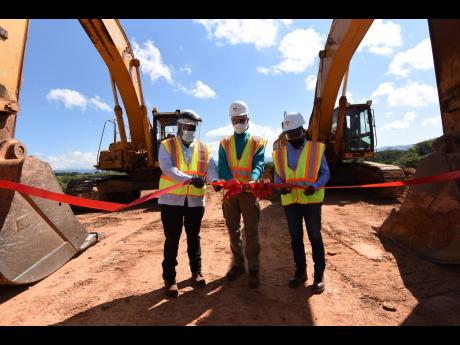Windalco banks on additional waste-holding pond to protect Rio Cobre
Having been blamed – and even prosecuted – for a number of fish kills in the past and with the State’s environmental watchdog last year saying that Windalco had not been doing enough to protect the Rio Cobre, the St Catherine-based company on Thursday broke ground for the construction of a second effluent holding pond.
Windalco – West Indies Alumina Company – is hoping that the new US$4-million pond, which is located at its Ewarton operations on roughly 25 acres of land and which will hold approximately 80 per cent more effluent than the existing pond, will be completed in the next two years to decrease the likelihood of any future effluent run-off contaminating the Rio Cobre, which many residents rely on for their livelihoods.
“Our intention and purpose for this project [is] to eliminate any potential ... spillage into the waters of the Rio Cobre and even to create a reserve in case of the extension of our enterprise [and] to eliminate any risk and any potential risks,” said Sergey Kostyuk, Windalco country manager.
Last year, the alumina refinery was charged with violation of the Wild Life Protection Act after the National Environment and Planning Agency (NEPA) blamed it for a fish kill in the Rio Cobre resulting from the spillage of effluent – sewage or liquid waste from treatment plants, pipes, or industrial operations.
Last September, NEPA told The Gleaner that the Rusal-owned Windalco had been the “only entity” found to have repeatedly polluted the Rio Cobre, resulting in fish kills, with four such strikes beside its name in the last decade.
The company has denied being the source of the problem in a number of instances.
Yesterday, Mining Minister Robert Montague described Windalco as an “excellent corporate citizen”, saying that while “there has been contamination of the Rio Cobre from time to time”, the company has prioritised making a positive social impact while acting ethically to ensure long-term environmental sustainability of its operations.
He added that his ministry, in partnership with the Jamaica Bauxite Institute, has been facilitating discussions with Windalco to address the problems.
“I am pleased this morning to know that the pleas and the cries of the citizens and the wider Jamaica have not fallen on deaf ears,” said Montague.
Windalco is also planning to extend its existing bauxite red mud lake in short order to boost wastewater catching capacity by 60,000 cubic metres.
“No longer, once there is rain, will we have any contamination from the bauxite red mud lake getting into the Rio Cobre. If there is contamination after this, it must be from another source, but certainly not from Windalco,” said Montague, noting that any overflow that may occur at the original pond will run into the new pond.
“Protection of our environment has to be front and centre, and I am of the view that mining can be sustainable because there has to be a balance between extracting what God has given us in making life easier and also protecting the environment for the future generation,” said Montague.
Since January 2011, at least 14 fish kills have been recorded in St Catherine, with seven occurring in the Rio Cobre, including the four NEPA has tagged to Windalco in July 2011, July 2018, October 2019, and more recently, in August last year. Windalco was prosecuted in the first instance, with the company paying “a substantial [undisclosed] sum”, according to NEPA.
High turbidity, elevated storm water conditions, and an “unknown” factor were to blame in the initial other three cases, the environmental agency said.

